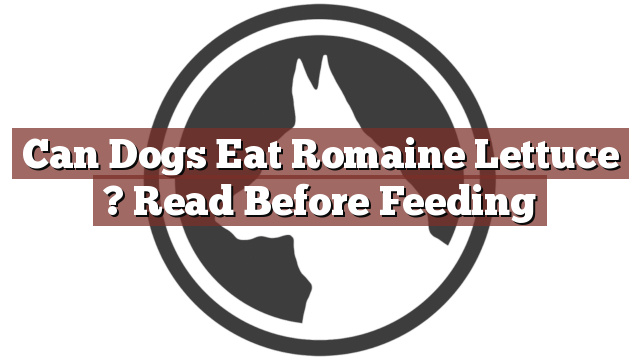Understanding Your Dog’s Dietary Needs
As responsible dog owners, it is important to understand the dietary needs of our furry friends. While dogs are primarily carnivores, they can also benefit from some fruits and vegetables in their diets. However, it is crucial to consider which foods are safe for them to consume. One common question that arises is, can dogs eat romaine lettuce? Before you decide to introduce romaine lettuce into your dog’s diet, it is important to gather all the necessary information to make an informed decision.
Can Dogs Eat Romaine Lettuce? Read Before Feeding
The answer to the question of whether dogs can eat romaine lettuce is a resounding yes. Romaine lettuce is safe and even healthy for dogs to consume. It contains several essential nutrients such as vitamins A, C, and K, as well as folate and fiber. These nutrients can contribute to your dog’s overall health and well-being. However, it is crucial to prepare the romaine lettuce correctly before feeding it to your dog. Make sure to wash the lettuce thoroughly to remove any dirt or pesticides that may be present. Additionally, it is important to chop or tear the lettuce into small, bite-sized pieces to prevent choking hazards.
Pros and Cons of Feeding Romaine Lettuce to Dogs
Feeding romaine lettuce to your dog can have several benefits. As mentioned earlier, it is a good source of vitamins and fiber, which can support your dog’s digestive system and help maintain a healthy weight. The high water content in romaine lettuce can also contribute to hydration, especially during hot summer months. Moreover, the crunchy texture of romaine lettuce can provide a satisfying chewing experience for dogs, promoting dental health and reducing the risk of gum diseases.
While there are many advantages to feeding romaine lettuce, it is important to consider some potential drawbacks as well. Some dogs may have difficulty digesting lettuce, leading to gastrointestinal issues such as diarrhea or vomiting. Therefore, it is crucial to introduce romaine lettuce gradually and observe your dog’s reaction to it. Additionally, it is important to keep in mind that romaine lettuce should only be given as a treat or supplement to your dog’s regular balanced diet, rather than replacing their main source of nutrition.
Conclusion: Considerations Before Including Romaine Lettuce in Your Dog’s Diet
In conclusion, romaine lettuce can be a healthy addition to your dog’s diet, as long as it is prepared and introduced correctly. Before feeding romaine lettuce to your dog, it is important to understand your dog’s dietary needs and consult with a veterinarian if you have any concerns. Remember to wash and chop the lettuce appropriately to ensure your dog’s safety and prevent any potential choking hazards. Additionally, monitor your dog’s reaction to the lettuce and make sure to incorporate it as a treat or supplement rather than a replacement for their regular diet. By considering these factors, you can safely include romaine lettuce in your dog’s diet and provide them with additional nutrients for a healthy and balanced lifestyle.
Thank you for taking the time to read through our exploration of [page_title]. As every dog lover knows, our furry friends have unique dietary needs and responses, often varying from one canine to another. This is why it's paramount to approach any changes in their diet with caution and knowledge.
Before introducing any new treats or making alterations to your dog's diet based on our insights, it's crucial to consult with a veterinarian about [page_title]. Their expertise ensures that the choices you make are well-suited to your particular pet's health and well-being.
Even seemingly harmless foods can sometimes lead to allergic reactions or digestive issues, which is why monitoring your dog after introducing any new food item is essential.
The content provided here on [page_title] is crafted with care, thorough research, and a genuine love for dogs. Nevertheless, it serves as a general guideline and should not be considered a substitute for professional veterinary advice.
Always prioritize the expert insights of your veterinarian, and remember that the health and happiness of your furry companion come first.
May your journey with your pet continue to be filled with joy, love, and safe culinary adventures. Happy reading, and even happier snacking for your canine friend!

